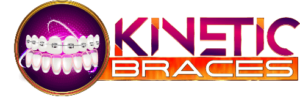Orthodontic Treatments For Sleep Apnea
Our team at Kinetic Braces, led by Dr. Simmons, can help you overcome your sleep apnea. We offer orthodontic treatments to help adjust your airway, reducing the effects of sleep apnea.
What Is Sleep Apnea?
Patients with sleep apnea repeatedly wake up because their breathing has been interrupted. The disorder is disruptive for both the person who suffers from it and their sleeping companion, as the jerks can last anywhere from a few seconds to several minutes. There are three types of sleep apnea:
-
- Obstructive Sleep Apnea – OSA is the most common type of sleep apnea and occurs when the muscles in the back of the throat relax too much. As the airway becomes constricted during sleep from obstructive apnea, the brain responds by instructing the nasal passages to take over. Even if the problem has been fixed, the person’s sleep schedule has been disrupted. It’s not uncommon for there to be as many as thirty interruptions in an hour.
- Central Sleep Apnea – Less common than obstructive sleep apnea is central sleep apnea, which occurs when the brain is unable to relay information effectively to the muscles that regulate breathing during sleep.
- Complex Sleep Apnea – Complex sleep apnea (also called treatment-emergent central sleep apnea) is a combination of both obstructive and central sleep apnea.
Sleep Apnea Symptoms
If you are concerned that you or someone you know has sleep apnea, here are the most common symptoms to look for:
-
- Loud snoring
- Gasping for air while sleeping
- Insomnia
- Waking with a dry mouth
- Mouth breathing while sleeping
- Morning headaches
There are other symptoms that are a result of the lack of sleep that can come with sleep apnea, including tiredness during the day, irritability, dizziness, and more. If you are experiencing these symptoms, call Kinetic Braces, and we can help determine if sleep apnea treatment in Kansas City, MO, is right for you.
Appliances For Sleep Apnea
If you have sleep apnea, Kinetic Braces offers affordable dental appliances to treat the orthodontic issue causing it. We work with insurance like BlueCross, Medicare, Cigna, and more to help our patients get the appliances they need. In most cases, the insurance company will dictate the appliance you will receive, but all treatment options are for the purpose of treating symptoms of sleep apnea and airway/snoring. At Kinetic Braces, Dr. Simmons offers the following options:
Braces & Aligners
Misaligned teeth, which can lead to obstructive sleep apnea, can be corrected with braces or aligners. Teeth are moved gently but steadily out of their improper positions and into ones where they won’t obstruct breathing using these devices. Treating sleep apnea in children and adults can be accomplished with either braces or aligners, but the aligners are a less obvious option.
Rapid Palate Expander
Children with obstructive sleep apnea may be treated with a rapid palate expander. Cemented bands or bonding secure the device to the patient’s upper molars, and the bridging component of the appliance spans the width of the patient’s palate. Rapid palate expanders help make more room in the upper jaw.
Mandibular Advancement Splint
A mandibular advancement splint is designed to realign the jaw as you sleep. There is a very modest forward and downward movement of the lower jaw as a result of this device. Symptoms of obstructive sleep apnea are alleviated as a result of this little adjustment, which works by opening up the airway.
Treating Airway Disorders With Orthodontics
Kinetic Braces offers more than just straight teeth for people with airway problems. We provide comprehensive care that includes industry-leading methods for treating airway blockages and sleep disorders. To begin, Dr. Simmons will examine your nasal passages, sinuses, jaw development, and facial structural alignment.
Treatments that rely only on anti-snoring devices can be effective, although they are typically insufficient. These techniques do not address the source of certain problems. Combining these devices with frenectomy and other surgeries for narrow palates, enlargement of the arches, and other difficulties will yield greater results.
Using X-rays, 3D imaging, and visual examinations, Dr. Simmons will study your oral architecture and facial muscles to uncover the underlying reasons for airway problems during your first airway orthodontics session. Following the evaluation, we will build a treatment plan that is unique to you.
What Are Habit Appliances?
A habit appliance is a painless and simple solution to finally rid your child of oral development-harming habits, such as thumb sucking and tongue thrusting. Even while these habits are common in infants and toddlers, if they persist beyond the first few years of life, they can result in an incorrect bite.
Thumb-Sucking
A thumb-sucking device is effective because it makes it uncomfortable for the child to continue the behavior. The device is composed of acrylic and fits over the upper arch teeth but is easily removable, making cleaning and flossing simple.
Tongue-Thrusting
Tongue thrusting is a pattern of pushing one’s tongue against the teeth while swallowing or speaking. To counter this, Dr. Simmons offers an appliance that has a tongue-retaining shield. This keeps the tongue from pressing down on the lower front teeth and helps to discourage it from happening again.
